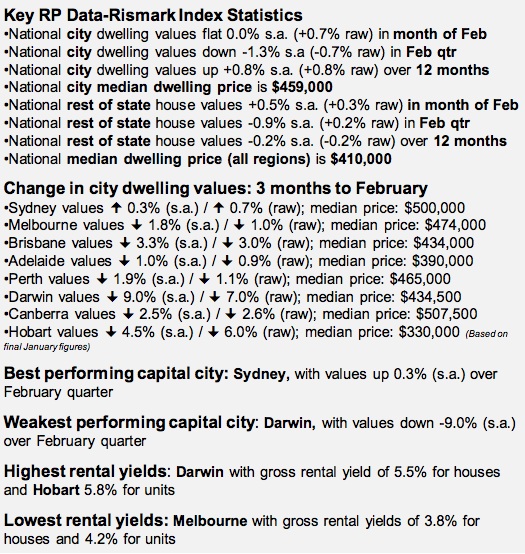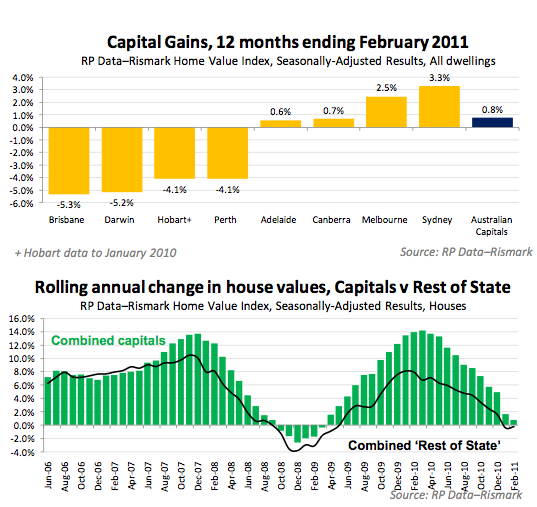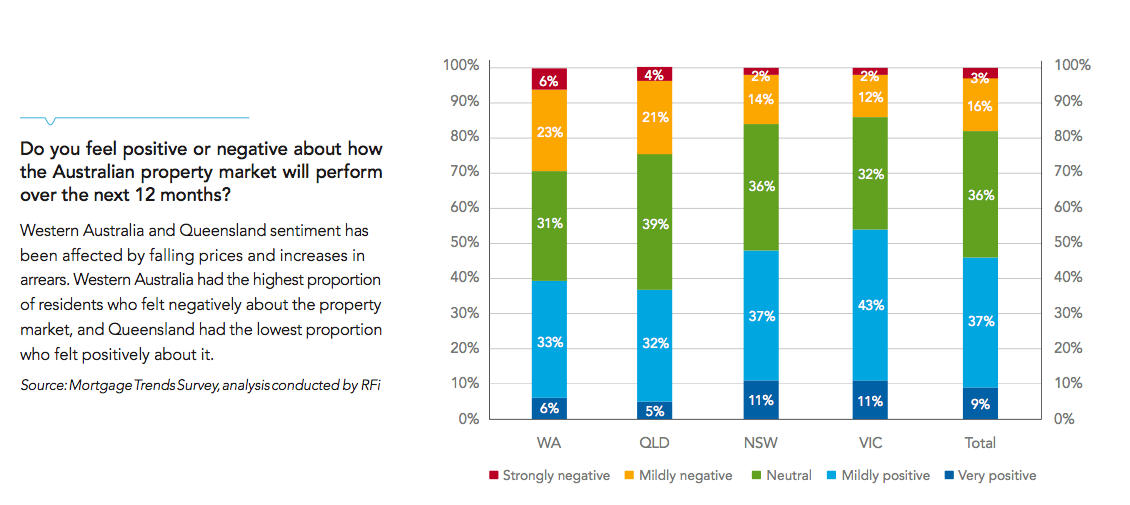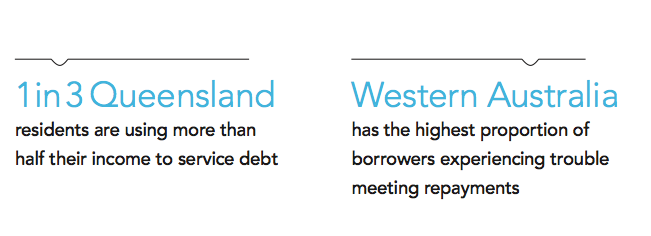A couple of new statements/reports out today about the housing market. First RPData have their monthly statement.
Housing flat in February with only 0.8 per cent growth over last year:
February’s index result (0.0 per cent s.a.) suggests that Aussie home values continue to tread water despite robust household income growth. There was little revision to RP Data-Rismark’s January estimates.
After a natural disaster-affected January (-1.5 per cent seasonally-adjusted [was -1.6 per cent] or -0.7 per cent ‘raw’ [was -0.9 per cent]), RP Data-Rismark’s Hedonic Index reports that Australian home values held ground during the month of February.
In the capital cities, RP Data-Rismark recorded flat dwelling values (0.0 per cent seasonally-adjusted or a slightly stronger +0.7 per cent in actual ‘raw’ terms). The ‘rest of state’ areas, which account for the 40 per cent of homes not located in the capitals, also displayed some improvement during February with house values rising by 0.5 per cent seasonally-adjusted (+0.3 per cent raw).
Over the 12 months to end February, Australia’s capital city home values have hardly moved, rising by only 0.8 per cent. The story is the same in the rest of state regions, where home values remain unchanged (-0.2 per cent) over the last year.
The median dwelling price in the capital cities has eased down to $459,000 over the three months to end February from a peak of $473,000. (Note: rates of return or capital growth should not be inferred from these medians.) The median in the rest of state markets is markedly lower at just $323,000. Across all Australian regions, the national median dwelling price was $410,000 over the past quarter.
Now I know these statements fit well with the “soft landing” crew, but I think the wide angle lens is hiding some real issues. If we drill down on some of the actual cities you can see that Sydney and Melbourne are doing some very heavy lifting to compensate for other areas. However both of these markets continue to slow. Call me contrarian but I see little evidence that a “landing” is occurring.

 As I said recently it is 2008 all over again, the bottom graph show you why I have been saying that and why I am “on watch” for government intervention.
As I said recently it is 2008 all over again, the bottom graph show you why I have been saying that and why I am “on watch” for government intervention.
Genworth Finance also produced a very interesting report this week. For those of you who are not aware of Genworth they claim to be.
A leading provider of Lenders Mortgage Insurance (LMI) and credit enhancement product solutions in Australia and New Zealand. Working closely with our partners, our aim is to make home ownership more accessible to borrowers through the provision of LMI solutions.
They produce a bi-annual report called Streets ahead which is basically a survey on confidence and debt serviceability in the housing market. Their latest report is a very interesting read. I recommend you read the entire report but here are some key statements, many of which will come as little surprise to my regular readers.
National disasters tip confidence
In the 2010 Index released in September last year, we found homebuyer confidence was on a delicate balance as borrowers remained cautious about rising interest rates and higher costs of living. The March 2011 Index, based on a survey of consumers conducted in February, finds the recent devastating natural disasters have weighed heavily on confidence. Growing debt discomfort and higher incidences of mortgage stress in affected states have caused the Index to fall by 1.5% from 2010 levels. Indeed, national homebuyer sentiment would have increased by 0.8% if it wasn’t for the drop in consumer sentiment in Queensland; the state most affected by events of the past summer.
Genworth’s hardship data, which helps paint a clearer picture of borrower distress, tells a similar story. Total hardship requests increased by over 70% in 2011 (to mid-March) compared to the same period last year. Nearly half (40%) of these requests were natural disaster-related, mainly driven by the flooding in Queensland.
A telling trend from the survey showed that one in five (21%) respondents affected by the flooding in Queensland believed it would take them more than six months to get back on their feet, beyond the standard three month hardship solutions currently offered by many lenders.
Queensland and Western Australia the most fragile
It’s not just flooding, cyclones and bushfires that are impacting the country’s resources states. Other data shows house prices are declining across Queensland and Western Australia after years of strong economic growth. Residents of these states are not only showing greater pessimism about the housing market than the rest of the country, but are also experiencing greater difficulty servicing their debt. In fact, 9% of Western Australia residents surveyed said they had trouble making their debt repayments every month, compared to the national average of just 3%.
Higher cost of living adds to borrower hardship
The rising cost of living, in particular higher food prices, has become the main concern for borrowers expecting difficulty meeting mortgage repayments. This has overtaken concern over interest rates rises, which most troubled borrowers in 2010.
First homebuyers are upbeat but the year ahead will be the real test
After some concern first homebuyers (FHBs) over-committed in the bid to take advantage of the government incentives in 2008 and 2009, Streets Ahead finds these borrowers are faring well. They’re more confident than the average, are less likely to have experienced mortgage stress and are also more comfortable with higher debt levels. But the year ahead could be crunch time, with nearly one in four FHBs expecting to find it hard to meet their mortgage commitments.
I think this an interesting point, first home buyers are confident coming out of very stimulatory environment with low interest rates. 2011 is the year where that confidence meets the “new normal” with nearly 25% of this cohort claiming they are going to struggle to meet their mortgage commitments. I am not sure we are going to see a major rise in direct delinquencies come out of this , although there has been some recent uptick, but the psychological effect of seeing friends struggling to make ends meet is sure to have an effect on new entrants to the market.
Growing discomfort despite unchanged debt levels
Turning back to trends across the nation, household debt levels did not change during the period, with 27% of respondents in both 2010 and 2011 surveys putting half or more of their monthly income to paying off debt. However, households have become more conservative about how much debt they are willing to take on, with the proportion willing to borrow more than 80% of a property’s value falling 10% from 39% to 29%. This suggests that other factors such as the rising cost of living are causing borrower concern.
Queensland residents have a larger debt burden than other Australians, with one in three using more than half their income to service debt. Although the level of debt is increasing for Queensland and Western Australia, these residents are only marginally less comfortable in borrowing larger amounts.
Mortgage stress up, but borrowers remain optimistic
Though household debt levels have remained constant, the rising cost of living and the effects of natural disasters have led to a greater degree of borrower stress with 21% of borrowers finding it difficult to meet their mortgage repayments in the 2011 survey, up from 15% in September 2010. This increased stress sees borrowers less willing to become more leveraged or invest in new property.
Unsurprisingly, Queensland and Western Australia residents were more likely to have experienced trouble making repayments, with Western Australia residents having the highest proportion of borrowers who experienced trouble meeting repayments in every month.
Despite past strain, borrowers remain fairly optimistic about their ability to meet repayments over the coming year, perhaps due to the expectation interest rates will remain unchanged in the short-term.
If households are spending half their income servicing debt one has to ask what happens if one of the income earners comes unstuck. In an environment of disleveraging I get the feeling the average Australian simply doesn’t understand the macroeconomic forces that are now driving the the broader economy. The following chart displays this beautifully.
 Even in times of mortgage stress the housing dream lives on.
Even in times of mortgage stress the housing dream lives on.
